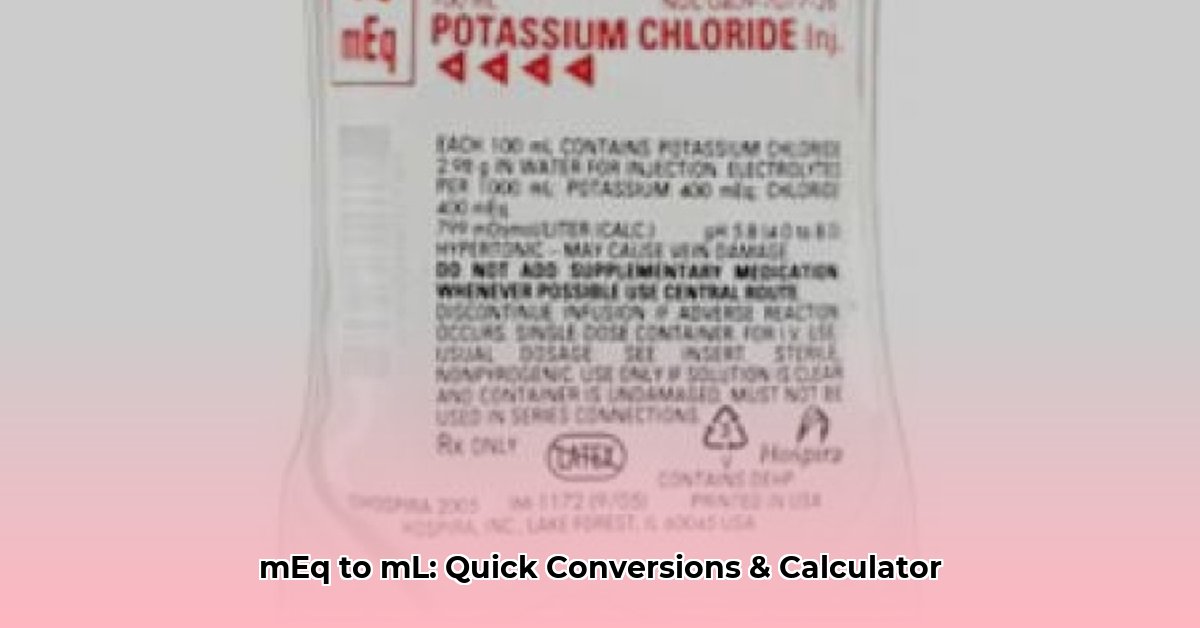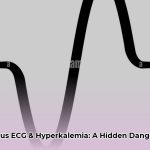Understanding the Basics
Converting milliequivalents (mEq) to milliliters (mL) is a crucial skill in healthcare and chemistry, ensuring accurate dosages and preparation of solutions. This guide provides a clear, step-by-step approach to performing these conversions, using real-world examples and addressing common pitfalls.
Why Precise Conversions Matter
Electrolytes like potassium, magnesium, and calcium are essential for proper bodily function. Maintaining the right balance of these electrolytes is critical, and inaccurate conversions can lead to serious health consequences. mEq to mL conversions ensure the correct amount of these vital substances is administered, particularly important for IV infusions and pediatric doses.
Decoding mEq, mL, and Concentration
-
Milliequivalent (mEq): Measures the chemical activity of a substance, reflecting its ionic charge. One mEq of a substance with a single charge (like potassium, K⁺) is equivalent to one millimole (mmol). However, for substances with multiple charges (like magnesium, Mg²⁺), one mmol equals two mEq.
-
Milliliter (mL): A simple measure of volume.
-
Concentration (mEq/mL): The bridge connecting mEq and mL. It quantifies how much “active ingredient” (mEq) is present in each milliliter of solution.
The Core Formula and Step-by-Step Instructions
The fundamental formula for converting mEq to mL is:
mL = mEq / (Concentration in mEq/mL)
Here’s how to apply it:
-
Determine the required mEq: This is the prescribed dose of the electrolyte.
-
Identify the concentration (mEq/mL): This is found on the medication label and is crucial for accurate conversion.
-
Perform the calculation: Divide the mEq (step 1) by the concentration (mEq/mL) (step 2). The result is the required volume in mL.
-
Double-check your work: Errors can have significant consequences. Verification is essential, especially for critical medications.
Practical Examples: Potassium Chloride (KCl)
-
Example 1: A patient needs 20 mEq of KCl, and the available solution has a concentration of 2 mEq/mL. Calculation: 20 mEq / 2 mEq/mL = 10 mL.
-
Example 2: The same 20 mEq dose is required, but the KCl solution has a concentration of 4 mEq/mL. Calculation: 20 mEq / 4 mEq/mL = 5 mL. Notice how a higher concentration requires a smaller volume.
Practical Examples: Magnesium Sulfate (MgSO4)
Magnesium sulfate adds complexity due to various hydrated forms (containing water molecules). These examples use magnesium sulfate heptahydrate (MgSO4•7H2O).
-
Example 3: A patient requires 16 mEq of magnesium, and the solution has a concentration of 4 mEq/mL. Calculation: 16 mEq / 4 mEq/mL = 4 mL.
-
Example 4: Percentage Concentrations: A 10% w/v solution means 10 grams of MgSO4•7H2O are in 100 mL. Converting this to mEq/mL requires considering the molecular weight of MgSO4•7H2O and the valence of magnesium (2+). This calculation is more intricate and may involve several steps. Consult a pharmacist or reliable resources for detailed guidance on percentage conversions.
Navigating Potential Pitfalls
-
Incorrect Concentration: Always double-check the label to ensure you are using the correct concentration.
-
Variations in Real-World Conditions: Factors like temperature and measurement accuracy can introduce slight variations.
-
Magnesium Sulfate Forms: Be mindful of the different forms of magnesium sulfate and their varying molecular weights. Using the incorrect form in calculations can lead to significant dosing errors.
Additional Tips for Accuracy
-
Consult Resources: When in doubt, refer to reliable resources like drug formularies or consult with a pharmacist.
-
Use a Calculator: For complex calculations, a calculator can help ensure accuracy.
-
Stay Updated: Ongoing research may lead to refined conversion methods and best practices.
Addressing Uncertainties
It’s important to remember that medical and scientific knowledge is constantly evolving. While this guide provides current best practices, ongoing research may refine our understanding of mEq to mL conversions. Some experts suggest exploring alternative approaches to calculating magnesium sulfate concentrations, particularly with percentage solutions. Further research may lead to simpler and more standardized methods.
By following these guidelines and remaining vigilant about potential errors, healthcare professionals can ensure accurate mEq to mL conversions, contributing to patient safety and effective treatment.
- Water Wheel Electric Generator Provides Free Home Electricity - December 15, 2025
- Choosing the Right Portable Hydro Turbine for Your Needs - December 14, 2025
- Best Portable Hydro Generators for Off-Grid and Outdoor Power - December 13, 2025
















